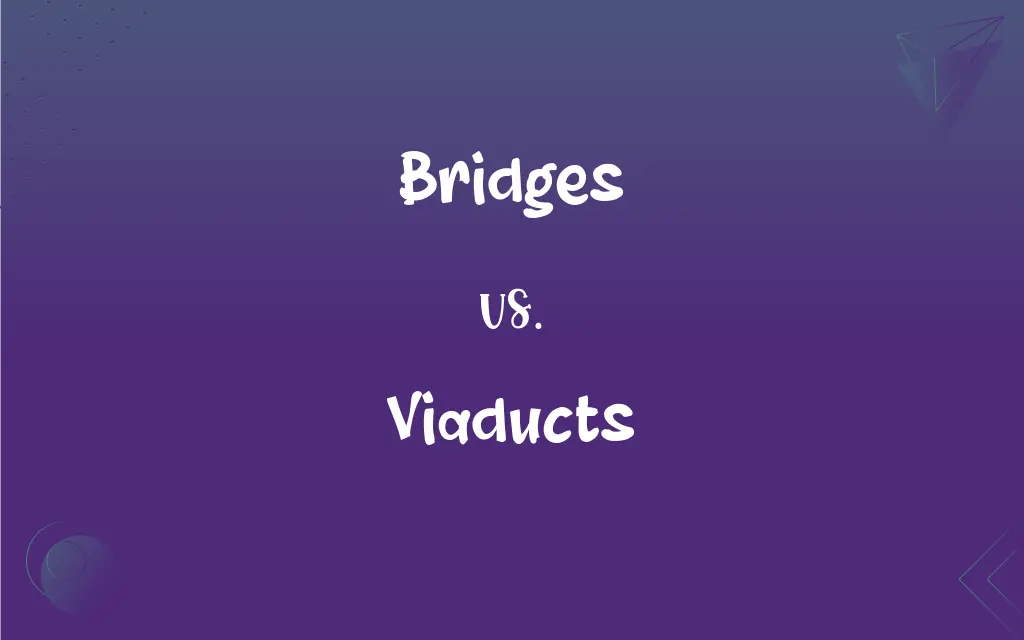Bridges vs. Viaducts: What's the Difference?
Edited by Aimie Carlson || By Janet White || Published on February 27, 2024
A bridge is a structure spanning a physical obstacle to provide passage, while a viaduct is a specific type of long bridge supported by a series of arches or spans, typically used for crossing valleys or gorges.

Key Differences
Bridges are diverse structures designed to span physical obstacles like rivers, valleys, or roads, primarily for the purpose of providing passage. Viaducts, a subtype of bridges, are specifically designed for crossing over long stretches of terrain, often valleys or gorges, and are characterized by a series of arches or spans that support the roadway or railway above.
The design of bridges varies greatly depending on the obstacle they cross and the materials used, ranging from simple wooden footbridges to complex suspension or cable-stayed bridges. Viaducts are typically constructed with multiple spans supported by piers or arches, a design that is especially effective for covering longer distances and uneven terrain.
Historically, bridges have been built for millennia, evolving from simple logs or stones to sophisticated engineering marvels. Viaducts, with their distinctive series of arches, have their roots in ancient Roman engineering, exemplifying the Roman emphasis on building durable and extensive road networks.
In modern times, bridges are essential for transportation networks, facilitating the movement of vehicles, trains, and pedestrians. Viaducts are particularly significant in railway and highway systems where long, elevated passageways are needed to traverse challenging landscapes.
Beyond their functional role, bridges often hold cultural and symbolic significance, representing connection and progress. Viaducts, with their grand scale and architectural beauty, can become landmarks and symbols of engineering achievement, blending functionality with aesthetic appeal.
ADVERTISEMENT
Comparison Chart
Definition
Structures for crossing physical obstacles
Bridges with a series of spans or arches
Primary Function
Varied, for crossing rivers, roads, etc.
Specifically for long spans, like valleys
Structural Design
Diverse, based on need and location
Characterized by multiple arches or spans
Historical Origin
Ancient, with varied designs
Roman origins, with emphasis on long crossings
Symbolic Meaning
Connection, overcoming barriers
Engineering triumph, aesthetic significance
ADVERTISEMENT
Bridges and Viaducts Definitions
Bridges
A bridge designed for foot traffic.
The pedestrian bridge over the river offers a scenic route for walkers.
Viaducts
A long, elevated bridge-like structure.
The Millau Viaduct in France is an impressive elevated roadway spanning a valley.
Bridges
A structure spanning a gap to facilitate transportation.
The Golden Gate Bridge connects San Francisco to Marin County.
Viaducts
A viaduct carrying railway lines.
The nineteenth-century railway viaduct is still in use today.
Bridges
A bridge where the deck is hung below suspension cables.
The suspension bridge swayed gently in the wind, offering breathtaking views.
Viaducts
A viaduct with a series of arches supporting the road.
The old stone arch viaduct is a popular landmark in the countryside.
Bridges
A bridge carrying train tracks.
The railroad bridge was crucial for the efficient movement of trains across the valley.
Viaducts
A viaduct in an urban setting, often for traffic management.
The urban viaduct was built to ease congestion in the city center.
Bridges
A movable bridge with a section that can be raised or lowered.
The castle's drawbridge was lifted every night for security.
Viaducts
A viaduct offering scenic views.
Driving across the scenic viaduct, travelers enjoyed panoramic views of the landscape.
Bridges
Plural of bridge
Viaducts
A series of spans or arches used to carry a road or railroad over a wide valley or over other roads or railroads.
Bridges
United States labor leader who organized the longshoremen (1901-1990)
Viaducts
Plural of viaduct
FAQs
Are all viaducts made of arches?
Many are, but modern viaducts may use different structural forms.
What is a bridge?
A structure built to span a physical obstacle like water, a valley, or a road.
How do bridges differ in design?
Designs vary based on location, purpose, and materials, from simple wooden structures to complex suspension bridges.
Can a bridge be part of a building?
Yes, some bridges are integrated into buildings, especially in modern architecture.
How are bridges maintained?
Regular inspections and repairs ensure their safety and longevity.
What materials are used in bridge construction?
Common materials include wood, steel, concrete, and sometimes stone.
What distinguishes a viaduct from other bridges?
Its length and the series of multiple spans or arches.
How do bridges impact the environment?
They can affect local ecosystems but also offer new habitats and connectivity.
What is a viaduct?
A long bridge with a series of spans or arches, often used to cross valleys or uneven terrain.
What's the oldest known bridge?
Some of the oldest known bridges date back to ancient Mesopotamia and Egypt.
How do viaducts handle seismic activity?
Modern viaducts are designed with earthquake resistance in mind.
Are viaducts used for specific transportation types?
They are commonly used for railways and highways.
Do bridges play a role in urban planning?
Absolutely, they are crucial for transportation and city connectivity.
Do viaducts have a cultural significance?
Yes, they often become landmarks and symbols of engineering prowess.
What future innovations are expected in bridge construction?
Advances in materials and design continue to evolve, with a focus on sustainability and resilience.
What's the longest viaduct in the world?
As of my last update, the Danyang–Kunshan Grand Bridge in China is among the longest.
Are there famous bridges in literature or film?
Many bridges feature prominently in cultural works as symbols or settings.
Was the Roman Empire known for viaducts?
Yes, Romans built many viaducts, showcasing their advanced engineering.
Can viaducts be considered architectural art?
Yes, many viaducts are admired for their architectural beauty.
What are the challenges in building bridges?
Technical, environmental, and financial challenges are common.
About Author
Written by
Janet WhiteJanet White has been an esteemed writer and blogger for Difference Wiki. Holding a Master's degree in Science and Medical Journalism from the prestigious Boston University, she has consistently demonstrated her expertise and passion for her field. When she's not immersed in her work, Janet relishes her time exercising, delving into a good book, and cherishing moments with friends and family.
Edited by
Aimie CarlsonAimie Carlson, holding a master's degree in English literature, is a fervent English language enthusiast. She lends her writing talents to Difference Wiki, a prominent website that specializes in comparisons, offering readers insightful analyses that both captivate and inform.
































































